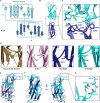Structure of the Y. pseudotuberculosis adhesin InvasinE
- PMID: 28370712
- PMCID: PMC5441405
- DOI: 10.1002/pro.3171
Structure of the Y. pseudotuberculosis adhesin InvasinE
Abstract
Enteropathogenic Yersinia expresses several invasins that are fundamental virulence factors required for adherence and colonization of tissues in the host. Within the invasin-family of Yersinia adhesins, to date only Invasin has been extensively studied at both structural and functional levels. In this work, we structurally characterize the recently identified inverse autotransporter InvasinE from Yersinia pseudotuberculosis (formerly InvasinD from Yersinia pseudotuberculosis strain IP31758) that belongs to the invasin-family of proteins. The sequence of the C-terminal adhesion domain of InvasinE differs significantly from that of other members of the Yersinia invasin-family and its detailed cellular and molecular function remains elusive. In this work, we present the 1.7 Å crystal structure of the adhesion domain of InvasinE along with two Immunoglobulin-like domains. The structure reveals a rod shaped architecture, confirmed by small angle X-ray scattering in solution. The adhesion domain exhibits strong structural similarities to the C-type lectin-like domain of Yersinia pseudotuberculosis Invasin and enteropathogenic/enterohemorrhagic E. coli Intimin. However, despite the overall structural similarity, the C-type lectin-like domain in InvasinE lacks motifs required for Ca2+ /carbohydrate binding as well as sequence or structural features critical for Tir binding in Intimin and β1 -integrin binding in Invasin, suggesting that InvasinE targets a distinct, yet unidentified molecule on the host-cell surface. Although the biological role and target molecule of InvasinE remain to be elucidated, our structural data provide novel insights into the architecture of invasin-family proteins and a platform for further studies towards unraveling the function of InvasinE in the context of infection and host colonization.
Keywords: C-type lectin-like domain; X-ray crystallography; Yersinia; adhesion; invasion; small angle X-ray scattering.
© 2017 The Protein Society.
Figures








Similar articles
-
The invasin D protein from Yersinia pseudotuberculosis selectively binds the Fab region of host antibodies and affects colonization of the intestine.J Biol Chem. 2018 Jun 1;293(22):8672-8690. doi: 10.1074/jbc.RA117.001068. Epub 2018 Mar 13. J Biol Chem. 2018. PMID: 29535184 Free PMC article.
-
Crystal structures of the outer membrane domain of intimin and invasin from enterohemorrhagic E. coli and enteropathogenic Y. pseudotuberculosis.Structure. 2012 Jul 3;20(7):1233-43. doi: 10.1016/j.str.2012.04.011. Epub 2012 May 31. Structure. 2012. PMID: 22658748 Free PMC article.
-
Identification and characterisation of a novel adhesin Ifp in Yersinia pseudotuberculosis.BMC Microbiol. 2011 Apr 28;11:85. doi: 10.1186/1471-2180-11-85. BMC Microbiol. 2011. PMID: 21527009 Free PMC article.
-
Adhesins of human pathogens from the genus Yersinia.Adv Exp Med Biol. 2011;715:1-15. doi: 10.1007/978-94-007-0940-9_1. Adv Exp Med Biol. 2011. PMID: 21557054 Review.
-
Yersinia infection tools-characterization of structure and function of adhesins.Front Cell Infect Microbiol. 2013 Jan 8;2:169. doi: 10.3389/fcimb.2012.00169. eCollection 2012. Front Cell Infect Microbiol. 2013. PMID: 23316485 Free PMC article. Review.
Cited by
-
The invasin D protein from Yersinia pseudotuberculosis selectively binds the Fab region of host antibodies and affects colonization of the intestine.J Biol Chem. 2018 Jun 1;293(22):8672-8690. doi: 10.1074/jbc.RA117.001068. Epub 2018 Mar 13. J Biol Chem. 2018. PMID: 29535184 Free PMC article.
-
Pan-genome survey of the fish pathogen Yersinia ruckeri links accessory- and amplified genes to virulence.PLoS One. 2023 May 11;18(5):e0285257. doi: 10.1371/journal.pone.0285257. eCollection 2023. PLoS One. 2023. PMID: 37167256 Free PMC article.
-
Escherichia coli surface display for the selection of nanobodies.Microb Biotechnol. 2017 Nov;10(6):1468-1484. doi: 10.1111/1751-7915.12819. Epub 2017 Aug 3. Microb Biotechnol. 2017. PMID: 28772027 Free PMC article. Review.
-
Effects of ESA_00986 Gene on Adhesion/Invasion and Virulence of Cronobacter sakazakii and Its Molecular Mechanism.Foods. 2023 Jun 30;12(13):2572. doi: 10.3390/foods12132572. Foods. 2023. PMID: 37444309 Free PMC article.
-
Yersinia Pseudotuberculosis Modulates Regulatory T Cell Stability via Injection of Yersinia Outer Proteins in a Type III Secretion System-Dependent Manner.Eur J Microbiol Immunol (Bp). 2018 Nov 28;8(4):101-106. doi: 10.1556/1886.2018.00015. eCollection 2018 Dec 23. Eur J Microbiol Immunol (Bp). 2018. PMID: 30719325 Free PMC article.
References
-
- Bottone EJ (1999) Yersinia enterocolitica: overview and epidemiologic correlates. Microbes Infect 1:323–333. - PubMed
-
- Isberg RR, Voorhis DL, Falkow S (1987) Identification of invasin: a protein that allows enteric bacteria to penetrate cultured mammalian cells. Cell 50:769–778. - PubMed
-
- Chauhan N, Wrobel A, Skurnik M, Leo JC (2016) Yersinia adhesins: an arsenal for infection. Proteomics Clin Appl. 10:949–963. - PubMed
-
- Leo JC, Oberhettinger P, Schütz M, Linke D (2015) The inverse autotransporter family: intimin, invasin and related proteins. Int J Med Microbiol 305:276–282. - PubMed
Publication types
MeSH terms
Substances
LinkOut - more resources
Full Text Sources
Other Literature Sources
Miscellaneous

